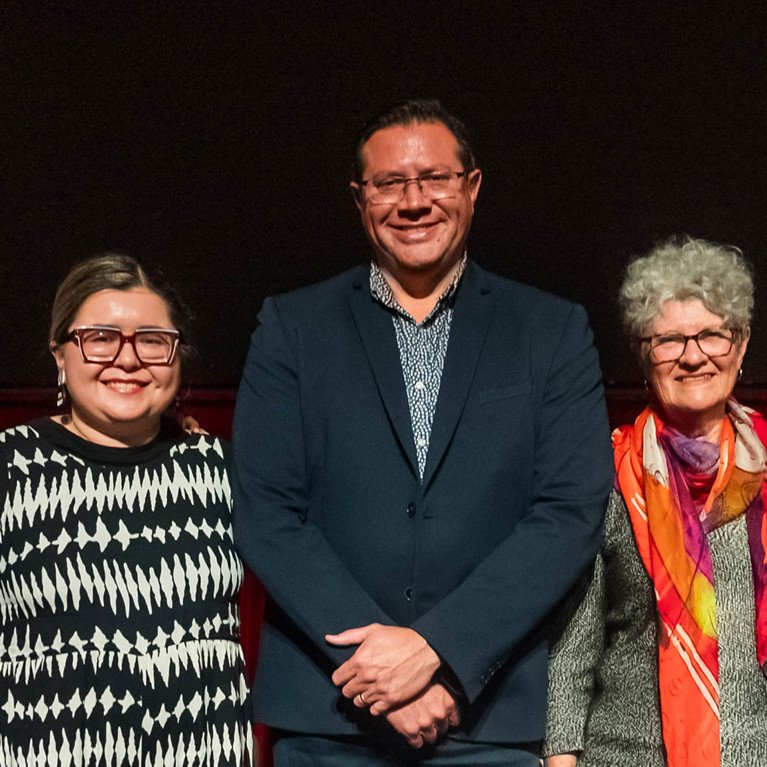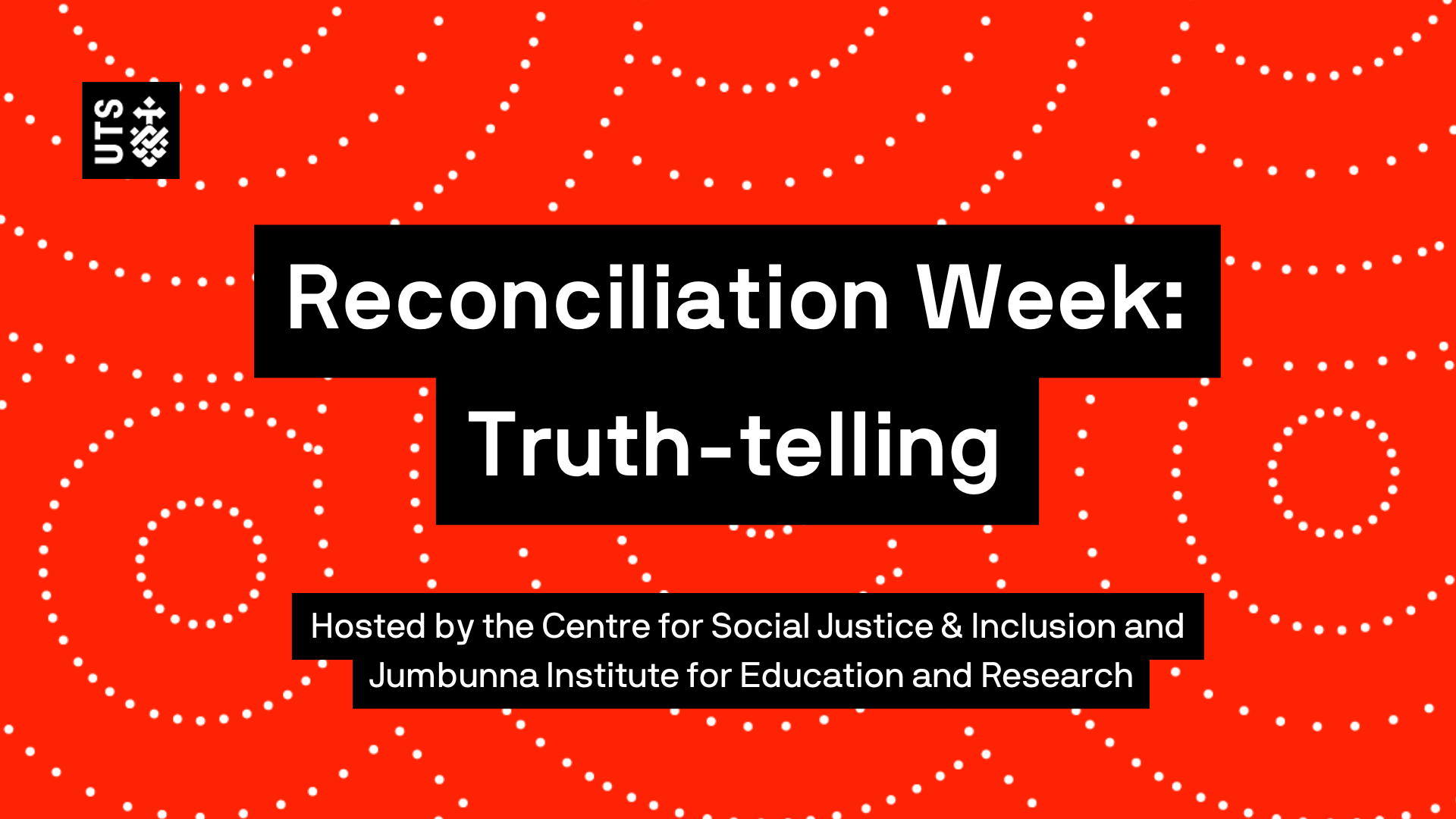- Posted on 4 Jun 2025
- 6 min 30 sec read
Facing Australia’s colonial history on the path to reconciliation
National Reconciliation Week invites us to reflect on the past and present and to have courage to face the truths of Australia’s black history, to build bridges and rally for a better future.
Truth-telling recognises Aboriginal and Torres Strait Islander peoples have continuously lived and practiced culture on this land for more than 60,000 years prior to colonisation in 1788 and acknowledges the strengths of First Peoples as well as the systematic silencing of injustices and ongoing impacts of colonisation.
During Reconciliation Week at UTS, Lorena Allam, Kate Grenville, Lindon Coombes and Mariko Smith joined Robynne Quiggin (moderator) to offer their insights into truth-telling and how it can lead to better awareness, understanding and connections across communities.
If you are interested in hearing about future events, please contact events.socialjustice@uts.edu.au.
‘The code of silence has lasted far too long and it's time to break that silence. Non-Indigenous Australians need to do this work, more than we do, because we know our history... We were never afforded the luxury of ignorance, and I think it's time for non-Indigenous Australians to catch up because we've been waiting for them down the track to come up and meet us.’ – Lorena Allam
‘I wanted to stand on the exact spot that my ancestors had taken, to name it to myself as taken – as stolen and to simply sit with that truth and see where that might lead me. It was a do-it-yourself truth-telling... It was of course, challenging when you look at our past – it is a vast, violent crime done by people like my ancestors and that violent past shapes the present, and that's why it's so important to get it right.’ – Kate Grenville
‘But in some of the truth-telling, my late awakening was that it's not for everyone else; it's for us. In doing that, and particularly the work around Treaty, it was: to tell our truths to each other, and then maybe we'll tell everyone else. It was a real moment for me that this is a fundamental part of our healing over this journey...’ – Lindon Coombes
‘Truth-telling in museums means confronting this colonial legacy while creating space for First Nations people to reclaim authority over their own stories. Real truth-telling requires transforming institutional power structures, not just adding First Nations content to existing colonial frameworks and structures.’ – Mariko Smith
‘At its core, reconciliation is about strengthening relationships between Aboriginal and non-Aboriginal people for the benefit of all Australians. Key to reconciliation is our relationship, and the process must weave together the threads of historical acceptance, race relations, equality and equity, institutional integrity and unity.’ – Robynne Quiggin
Speakers
Lorena Allam is a multiple Walkley award winning journalist descended from the Yuwalaraay and Gamilaraay people of northwest NSW. After a 30-year career as journalist and broadcaster at the ABC, she joined Guardian Australia in 2018 as its first Indigenous Affairs editor and has led news reporting on Indigenous issues including Aboriginal deaths in custody. In forays outside journalism, she worked on the landmark Bringing Them Home inquiry and helmed the Indigenous collection at the National Film and Sound Archive.
Kate Grenville is one of Australia’s most celebrated writers. In her most recent work Unsettled: A Journey Through Time and Place, she grapples with what it means to be a descendant of colonisation in Australia. Her international bestseller, The Secret River, was awarded local and overseas prizes, has been adapted for the stage and as an acclaimed television miniseries and is now a much-loved classic. In 2017, Grenville was awarded the Australia Council Award for Lifetime Achievement in Literature.
Professor Lindon Coombes is Industry Professor and Director at Jumbunna Institute for Indigenous Education and Research at UTS. Lindon is a descendant of the Yuallaraay people of northwest NSW and has worked in Aboriginal Affairs in a range of positions, including Director at PwC Indigenous Consulting, CEO of the National Congress of Australia’s First Peoples, and CEO of Tranby Aboriginal College in Glebe.
Dr Mariko Smith is the Head of First Nations Collections & Research at the Australian Museum. Mariko is a Yuin and Japanese interdisciplinary practitioner who engages with museology, public history, contemporary art, visual sociology, and research methodology. She specialises in truth-telling histories, Indigenous community-led cultural resurgence, and incorporating Indigenous ways of knowing and Indigenous cultural and intellectual property into museum practices. Mariko was the Assistant Curator on the award-winning Unsettled exhibition.
Professor Robynne Quiggin AO (moderator) is the Pro Vice-Chancellor (Indigenous Leadership and Engagement) at UTS. Robynne is a Wiradyuri lawyer who has worked on legal and policy issues relevant to Aboriginal and Torres Strait Islander peoples, including business, investment, financial services, consumer issues, human rights, governance, and rights to culture, heritage, and the arts.







